
ANDYBROUWER.CO.UK
CAMBODIA TALES 2003
Prasat Preah Neak Buos
- the thrill of discovery
The central brick tower of Prasat Preah Neak Buos
Originally constructed at the beginning of the 8th century by King Jayavarman I, Prasat Preah Neak Buos nestles at the foot of a promontory of the Dangrek Mountain range that forms a natural border between Thailand and northern Cambodia. Due to its remote location, inaccessibility and the ever-present danger posed by landmines, its one of the last remaining ancient Khmer temple sites to escape close scrutiny by archaeologists and tourists alike. The possibility of re-discovering an important temple that few have seen in years was the reason for my trip to the far north of Preah Vihear Province, an area that usually attracts adventurous travellers to its other major Angkorean temple sites at Preah Khan, Koh Ker and Prasat Preah Vihear.
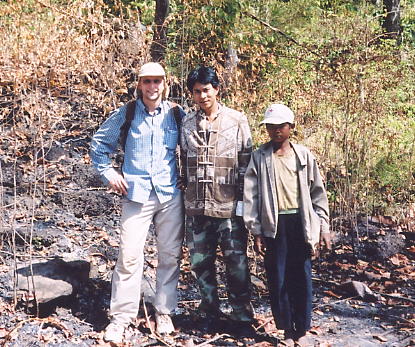 Prasat Preah Neak Buos is an unusual monument. Its
location demands that it faces south, and with various structures
added during the reign of different Kings, it houses an eclectic
cluster of temples rather than one large imposing structure.
Early inscriptions call the location at the foot of the mountain,
Canandagiri and the plain rectangular edifice of laterite and
brick first erected at the spot was known as Sivapadapurva. In
later years during the 10th and 11th centuries, particularly
under the guidance of Kings Jayavarman V and Suryavarman I,
additional monuments were built at the same locale, including two
brick temples with inscriptions facing east, whereas the original
temple faced westwards. In the eleventh century, a new group of
buildings were erected, with a large brick sanctuary holding
centre stage and other smaller edifices and galleries amidst the
rocky outcrops and boulders.
Prasat Preah Neak Buos is an unusual monument. Its
location demands that it faces south, and with various structures
added during the reign of different Kings, it houses an eclectic
cluster of temples rather than one large imposing structure.
Early inscriptions call the location at the foot of the mountain,
Canandagiri and the plain rectangular edifice of laterite and
brick first erected at the spot was known as Sivapadapurva. In
later years during the 10th and 11th centuries, particularly
under the guidance of Kings Jayavarman V and Suryavarman I,
additional monuments were built at the same locale, including two
brick temples with inscriptions facing east, whereas the original
temple faced westwards. In the eleventh century, a new group of
buildings were erected, with a large brick sanctuary holding
centre stage and other smaller edifices and galleries amidst the
rocky outcrops and boulders.
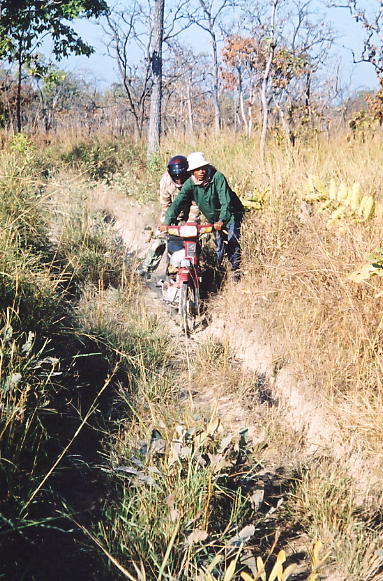 Located just a few kilometres east of the small town
of Choam Khsan, Prasat Preah Neak Buos was the only temple site
that the local inhabitants believed was still possible to visit.
A plethora of other temples in the vicinity were no longer
standing in their view, and with landmines making temple-hunting a risky business in
this part of Cambodia, I didn't have enough time to put their
theories to the test. Instead, Neak Buos would be our target and
we enlisted the help of Soveat, our guesthouse owner's son-in-law
and his fifteen year old nephew, Chamroeun. Both had visited the
temple and just one month before my arrival, they had escorted a
Japanese tourist to the site for the first time. Soveat assured
my moto-driver Sokhom and I, that whilst hostilities between
government and Khmer Rouge forces had stopped only five years
previously, landmines had been laid by both sides but outside the
temple walls and not inside the compound.
Located just a few kilometres east of the small town
of Choam Khsan, Prasat Preah Neak Buos was the only temple site
that the local inhabitants believed was still possible to visit.
A plethora of other temples in the vicinity were no longer
standing in their view, and with landmines making temple-hunting a risky business in
this part of Cambodia, I didn't have enough time to put their
theories to the test. Instead, Neak Buos would be our target and
we enlisted the help of Soveat, our guesthouse owner's son-in-law
and his fifteen year old nephew, Chamroeun. Both had visited the
temple and just one month before my arrival, they had escorted a
Japanese tourist to the site for the first time. Soveat assured
my moto-driver Sokhom and I, that whilst hostilities between
government and Khmer Rouge forces had stopped only five years
previously, landmines had been laid by both sides but outside the
temple walls and not inside the compound.
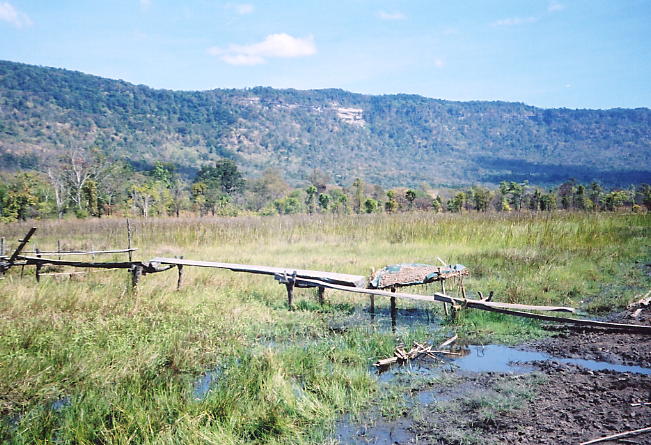 We
breakfasted at a market stall opposite our guesthouse, collected
provisions for our trip and left at 7.30am on two motos. Neak
Buos is a mere nine kilometres from Choam Khsan but for much of
the time, the trail consisted of deep sand and was impossible to
negotiate without walking. We criss-crossed three deep and dry
riverbeds, meandered along a cool and shady forest section and
got stuck in ox-cart tracks before we arrived at a police
checkpoint, a kilometre or so from the foot of the mountain
range, ninety minutes after setting off. The police had
practically no experience of foreigners before and
We
breakfasted at a market stall opposite our guesthouse, collected
provisions for our trip and left at 7.30am on two motos. Neak
Buos is a mere nine kilometres from Choam Khsan but for much of
the time, the trail consisted of deep sand and was impossible to
negotiate without walking. We criss-crossed three deep and dry
riverbeds, meandered along a cool and shady forest section and
got stuck in ox-cart tracks before we arrived at a police
checkpoint, a kilometre or so from the foot of the mountain
range, ninety minutes after setting off. The police had
practically no experience of foreigners before and 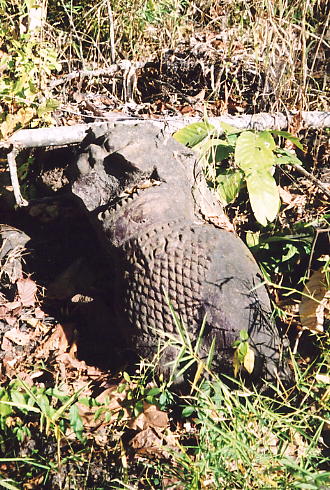 expressed
surprise that we wanted to visit Neak Buos. They confirmed that
there were no landmines inside the temple but that we must stick
to the trails for our own safety and waved us on our way. Soon
after we spied a laterite wall topped with sandstone blocks which
Soveat suggested we visit later in the morning and within a
minute or two, the main trail disappeared and we left the motos
to continue on foot. Walking through a forested area where mines
are a real threat is not my idea of fun but fifteen minutes later
we came upon another much larger laterite wall, which Soveat
confirmed was the southern entrance to Neak Buos. We had arrived.
Nearby, a broken lion statue and a finely carved colonette lying
in the grass made my eyes light up at the possibilities of what
lay in store just around the corner.
expressed
surprise that we wanted to visit Neak Buos. They confirmed that
there were no landmines inside the temple but that we must stick
to the trails for our own safety and waved us on our way. Soon
after we spied a laterite wall topped with sandstone blocks which
Soveat suggested we visit later in the morning and within a
minute or two, the main trail disappeared and we left the motos
to continue on foot. Walking through a forested area where mines
are a real threat is not my idea of fun but fifteen minutes later
we came upon another much larger laterite wall, which Soveat
confirmed was the southern entrance to Neak Buos. We had arrived.
Nearby, a broken lion statue and a finely carved colonette lying
in the grass made my eyes light up at the possibilities of what
lay in store just around the corner.
 The
southern entrance is a mishmash of building styles. On one side
is a well-defined stepped laterite wall, whilst the opposite side
is a natural ridge with sandstone boulders. The main entrance
staircase is overgrown, whilst brick and laterite structures lie
in ruin on top of the terrace behind. At one of the outer brick
buildings, a damaged lintel at the base of a sandstone doorframe
was ferociously guarded by red ants, a common theme throughout my
exploration. Walking through the undergrowth along a path of
sorts, we encountered another large entrance gopura, this time
constructed of brick
The
southern entrance is a mishmash of building styles. On one side
is a well-defined stepped laterite wall, whilst the opposite side
is a natural ridge with sandstone boulders. The main entrance
staircase is overgrown, whilst brick and laterite structures lie
in ruin on top of the terrace behind. At one of the outer brick
buildings, a damaged lintel at the base of a sandstone doorframe
was ferociously guarded by red ants, a common theme throughout my
exploration. Walking through the undergrowth along a path of
sorts, we encountered another large entrance gopura, this time
constructed of brick 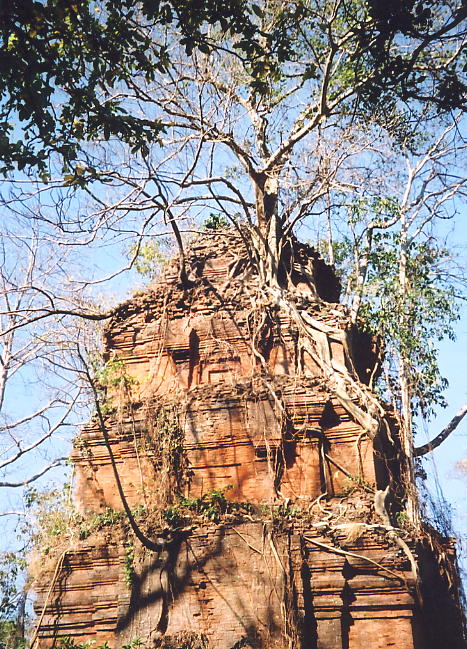 with a
distinctive sandstone double doorframe, before a laterite gopura
signalled the beginning of the inner enclosure, where the largest
collection of buildings were to be found. Negotiating our way
through the vegetation, which was at least two metres high, we
stumbled across a sandstone lintel showing Indra and the
three-headed elephant, Airavata, poking out of the earth and
likely to have come from one of the five brick towers to our
left, in the southwest corner of the enclosure. Thorn bushes made
up much of the foliage we encountered and I silently cursed
myself for not insisting that we brought with us some scythes or
axes to cut our way through. In the excitement of the morning,
I'd forgotten something so fundamental. As the sharp thorns
penetrated my shirt and trousers, I vowed not to make the same
mistake again.
with a
distinctive sandstone double doorframe, before a laterite gopura
signalled the beginning of the inner enclosure, where the largest
collection of buildings were to be found. Negotiating our way
through the vegetation, which was at least two metres high, we
stumbled across a sandstone lintel showing Indra and the
three-headed elephant, Airavata, poking out of the earth and
likely to have come from one of the five brick towers to our
left, in the southwest corner of the enclosure. Thorn bushes made
up much of the foliage we encountered and I silently cursed
myself for not insisting that we brought with us some scythes or
axes to cut our way through. In the excitement of the morning,
I'd forgotten something so fundamental. As the sharp thorns
penetrated my shirt and trousers, I vowed not to make the same
mistake again.
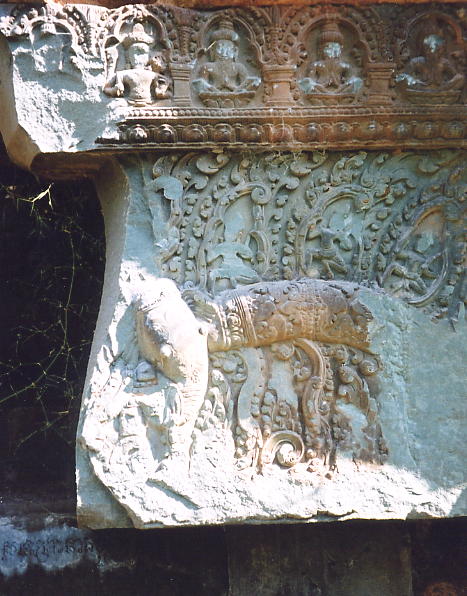 By-passing
a small laterite building, we headed for the largest of the
towers in the center of the inner enclosure. Like so many of the
more dramatic of Cambodia's ancient temples, this was partly
engulfed in the clutches of a strangler fig tree whose trunk
sprouted skywards from the top of the tower. As we got closer we
could hear the bats inside the tower signal our presence and the
smell of their droppings was overpowering when I peered into the
gloom of the sanctuary. The tower is of brick construction and
has a stepped-pyramid or tapered appearance, opening out to the
south. It was built later than most of the other structures and
has survived in a much better condition. The main doorway, the
three other doorways are false, boasted half a decorative lintel
with an elephant and hermits in meditation, and a
By-passing
a small laterite building, we headed for the largest of the
towers in the center of the inner enclosure. Like so many of the
more dramatic of Cambodia's ancient temples, this was partly
engulfed in the clutches of a strangler fig tree whose trunk
sprouted skywards from the top of the tower. As we got closer we
could hear the bats inside the tower signal our presence and the
smell of their droppings was overpowering when I peered into the
gloom of the sanctuary. The tower is of brick construction and
has a stepped-pyramid or tapered appearance, opening out to the
south. It was built later than most of the other structures and
has survived in a much better condition. The main doorway, the
three other doorways are false, boasted half a decorative lintel
with an elephant and hermits in meditation, and a  broken
colonette. Lying closeby was the other half of the lintel where
apsara dancers flying above the remaining two elephants had their
heads chipped away. I could find no other decoration on the tower
as we inched our way through the brush to a large laterite
gallery, with crude sandstone pillared windows, on the east side
of the courtyard. Climbing to the top to gain a better view of
our surroundings, we could just make out the pinnacle of at least
eight towers but it emphasised exactly how wildly overgrown with
vegetation the site was. We rested for a while, listening to the
quietness of the surrounding forest as our exertions had been
tiring and perspiration was running down my face and neck in
rivulets. The overhead sun was not yet at its zenith but it was
certainly hot and humid enough for me.
broken
colonette. Lying closeby was the other half of the lintel where
apsara dancers flying above the remaining two elephants had their
heads chipped away. I could find no other decoration on the tower
as we inched our way through the brush to a large laterite
gallery, with crude sandstone pillared windows, on the east side
of the courtyard. Climbing to the top to gain a better view of
our surroundings, we could just make out the pinnacle of at least
eight towers but it emphasised exactly how wildly overgrown with
vegetation the site was. We rested for a while, listening to the
quietness of the surrounding forest as our exertions had been
tiring and perspiration was running down my face and neck in
rivulets. The overhead sun was not yet at its zenith but it was
certainly hot and humid enough for me.
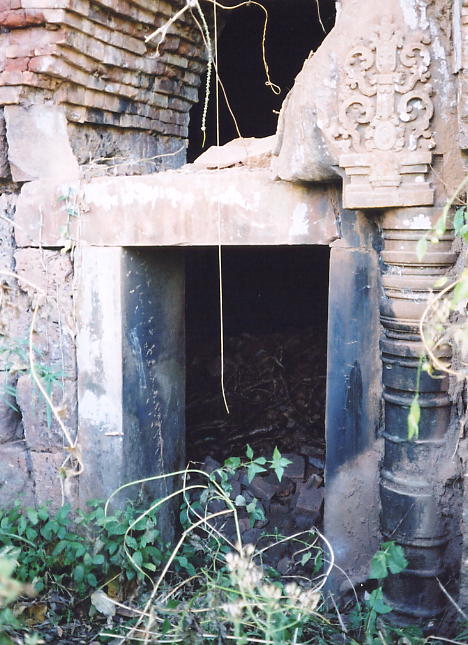 As
Sokhom and Soveat retraced our steps, Chamroeun, looking far
younger than his fifteen years, took me on a more difficult route
around the rear of the central brick tower, stepping gingerly
through the thorn bushes and on top of discarded bricks and
boulders. There was no path, we made it up as we went. A
sandstone lotus flower, fallen from the summit of a tower and
another half lintel protruding from the ground led us onto
another two brick towers, in various stages of ruin. Both opened
out to the east and both had inscriptions on their sandstone
doorjambs. Sokhom had joined us and read a few words from the
first one as it
As
Sokhom and Soveat retraced our steps, Chamroeun, looking far
younger than his fifteen years, took me on a more difficult route
around the rear of the central brick tower, stepping gingerly
through the thorn bushes and on top of discarded bricks and
boulders. There was no path, we made it up as we went. A
sandstone lotus flower, fallen from the summit of a tower and
another half lintel protruding from the ground led us onto
another two brick towers, in various stages of ruin. Both opened
out to the east and both had inscriptions on their sandstone
doorjambs. Sokhom had joined us and read a few words from the
first one as it  was
written in Pali, an old Khmer script whilst the second was in the
more ancient language of Sanskrit, which he couldn't read. I
couldn't find any other decoration on these two towers. Closeby
was the original temple, known as Sivapadapurva, built in the
eighth century and with its main doorway opening to the west. The
base of the tower was laterite, whilst the top half was made of
brick and housed another Sanskrit inscription, with some modern
graffiti superimposed, as well as a perfectly rounded colonette
and an intricate piece of carving. A few bats had also made their
home in the upper reaches of its sealed tower. Another brick
tower, opening out in a southern direction, stood a few metres
away.
was
written in Pali, an old Khmer script whilst the second was in the
more ancient language of Sanskrit, which he couldn't read. I
couldn't find any other decoration on these two towers. Closeby
was the original temple, known as Sivapadapurva, built in the
eighth century and with its main doorway opening to the west. The
base of the tower was laterite, whilst the top half was made of
brick and housed another Sanskrit inscription, with some modern
graffiti superimposed, as well as a perfectly rounded colonette
and an intricate piece of carving. A few bats had also made their
home in the upper reaches of its sealed tower. Another brick
tower, opening out in a southern direction, stood a few metres
away.
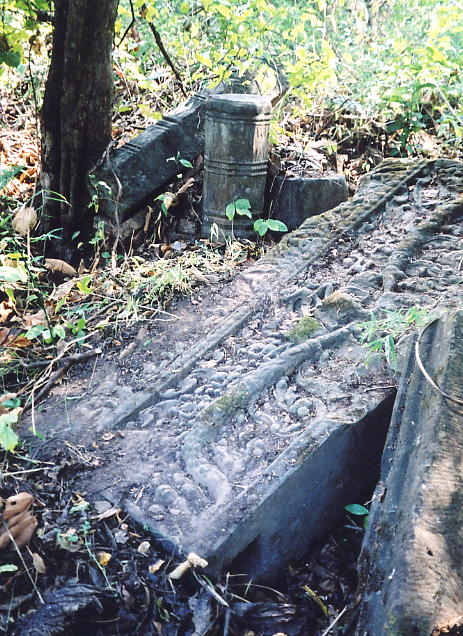 From
atop the gallery we had spied another set of structures, lying in
the southeast section of the enclosure and that's where we headed
next. We were two hours into our exploration of Prasat Preah Neak
Buos and whilst we hadn't exactly uncovered a real jewel in
comparison with other Khmer temples sites I'd visited, the thrill
of exploring a virgin site was no less palpable. Reaching the
southeast corner, next to the surrounding laterite wall were two
very ruined brick buildings. In front of the first was a large
lintel with Indra, Airavata and eight dancing figures in the
lower section and a row of hermits in the upper register.
Scrambling around in the undergrowth nearby, we found a portion
of carved stone with two
From
atop the gallery we had spied another set of structures, lying in
the southeast section of the enclosure and that's where we headed
next. We were two hours into our exploration of Prasat Preah Neak
Buos and whilst we hadn't exactly uncovered a real jewel in
comparison with other Khmer temples sites I'd visited, the thrill
of exploring a virgin site was no less palpable. Reaching the
southeast corner, next to the surrounding laterite wall were two
very ruined brick buildings. In front of the first was a large
lintel with Indra, Airavata and eight dancing figures in the
lower section and a row of hermits in the upper register.
Scrambling around in the undergrowth nearby, we found a portion
of carved stone with two 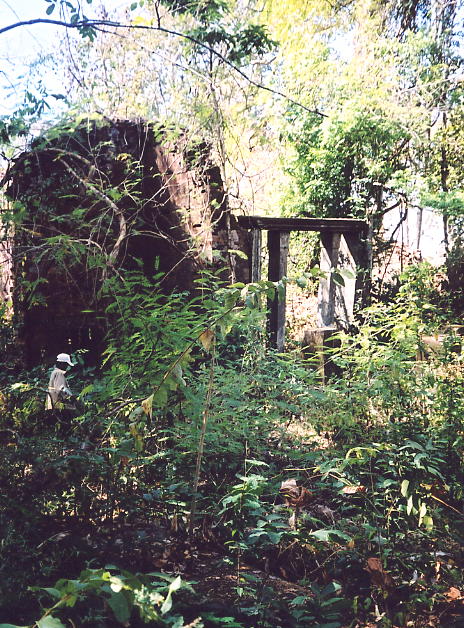 ascetics
meditating and some broken octagonal colonettes. At this point
the vegetation was extremely thick and I just managed to reach
one of two small sandstone towers, where two lintels with the
demon face of Kala were still in situ and another lay on the
ground. Balancing precariously on fallen blocks of stone, taking
photographs proved frustratingly difficult without hacking away
the undergrowth, which wasn't an option open to us. We'd reached
as many of the structures as we could within the main enclosure
and now headed for the large brick gopura with the double
sandstone doorframe. A row of rectangular sandstone posts
preceded the doorframe where I noticed a date carved on the
stone, 8.2.1904, most likely from one of the French
archaeologists that documented Cambodia's temples in the early
part of the twentieth century.
ascetics
meditating and some broken octagonal colonettes. At this point
the vegetation was extremely thick and I just managed to reach
one of two small sandstone towers, where two lintels with the
demon face of Kala were still in situ and another lay on the
ground. Balancing precariously on fallen blocks of stone, taking
photographs proved frustratingly difficult without hacking away
the undergrowth, which wasn't an option open to us. We'd reached
as many of the structures as we could within the main enclosure
and now headed for the large brick gopura with the double
sandstone doorframe. A row of rectangular sandstone posts
preceded the doorframe where I noticed a date carved on the
stone, 8.2.1904, most likely from one of the French
archaeologists that documented Cambodia's temples in the early
part of the twentieth century.
 After a
final inspection of the outer southern entrance, we ended our
visit to Neak Buos. The thick undergrowth, the vicious ants and
the incredibly hot and muggy conditions had made it a hard slog
for nearly three hours but the buzz and excitement of personally
discovering a major temple that few, if any, had visited for many
years, made it all worthwhile. We returned to our motos and
stopped at the laterite wall we'd seen earlier. Through the
foliage I could see a sandstone structure on the west side but we
could only enter the compound on the east side, where we found a
sandstone library with
After a
final inspection of the outer southern entrance, we ended our
visit to Neak Buos. The thick undergrowth, the vicious ants and
the incredibly hot and muggy conditions had made it a hard slog
for nearly three hours but the buzz and excitement of personally
discovering a major temple that few, if any, had visited for many
years, made it all worthwhile. We returned to our motos and
stopped at the laterite wall we'd seen earlier. Through the
foliage I could see a sandstone structure on the west side but we
could only enter the compound on the east side, where we found a
sandstone library with 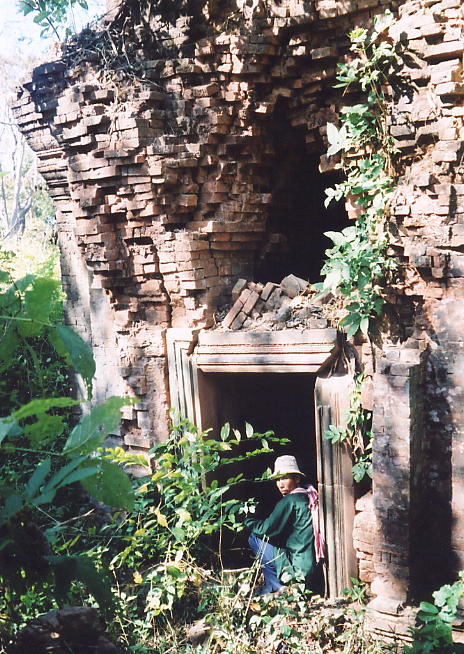 baluster
windows and a portion of a lintel. However, the vegetation was
even thicker than at Neak Buos and further exploration was simply
impossible. I'm unsure of the temple's name, maybe its Prasat
Neak Kuoi, though Soveat knew it only as "prasat kuk".
We stopped at the nearby police station for over an hour to eat
our beef and rice lunch and to mend two punctures on Soveat's
moto. Sokhom is an expert when it comes to moto
baluster
windows and a portion of a lintel. However, the vegetation was
even thicker than at Neak Buos and further exploration was simply
impossible. I'm unsure of the temple's name, maybe its Prasat
Neak Kuoi, though Soveat knew it only as "prasat kuk".
We stopped at the nearby police station for over an hour to eat
our beef and rice lunch and to mend two punctures on Soveat's
moto. Sokhom is an expert when it comes to moto  maintenance,
so I took the opportunity to grab a nap in the wooden police hut
whilst the half-dozen policemen either watched Sokhom at work or
collected catfish from a large lake closeby for their own lunch.
They re-iterated their surprise to see a foreigner visiting the
temple and I explained that more may follow in the near future.
I'm not sure how that news was received though they'd treated me
with genuine hospitality and warm smiles before we completed the
difficult journey back to town. We arrived at a small foodstall
at 3pm, in time for Soveat to watch Thai boxing on television and
for Sokhom and I to relax with fresh coconut juice and a cold
Sprite, at the end of a very satisfying day of adventure. If you
are seeking to explore a temple that doesn't conform to the more
sanitized versions you find at Angkor and you aren't afraid of a
bit of discomfort then Prasat Preah Neak Buos may be just what
you're looking for. If you do pay a visit, make sure you heed
seriously the warnings about landmines and are accompanied by a
knowledgable local.
maintenance,
so I took the opportunity to grab a nap in the wooden police hut
whilst the half-dozen policemen either watched Sokhom at work or
collected catfish from a large lake closeby for their own lunch.
They re-iterated their surprise to see a foreigner visiting the
temple and I explained that more may follow in the near future.
I'm not sure how that news was received though they'd treated me
with genuine hospitality and warm smiles before we completed the
difficult journey back to town. We arrived at a small foodstall
at 3pm, in time for Soveat to watch Thai boxing on television and
for Sokhom and I to relax with fresh coconut juice and a cold
Sprite, at the end of a very satisfying day of adventure. If you
are seeking to explore a temple that doesn't conform to the more
sanitized versions you find at Angkor and you aren't afraid of a
bit of discomfort then Prasat Preah Neak Buos may be just what
you're looking for. If you do pay a visit, make sure you heed
seriously the warnings about landmines and are accompanied by a
knowledgable local.
Click on any photo to enlarge
New For an in-depth look at Prasat Preah Neak Buos - click here
Here's links to the rest of my Cambodia Tales:
January 2003 marked my ninth trip to Cambodia since my first-ever visit in 1994. It's a country that has a special magic all of its own and which draws me back every year to venture out into the Cambodian countryside in search of new adventures, ancient temples and to catch up with the friends I've made from previous visits. Each trip is full of laughter, smiles and a host of fresh experiences and my latest expedition was no exception.
Home : Next : Messageboard : E-mail
The contents of this website cannot be reproduced or copied without permission of the site author. (c) Andy Brouwer 2005